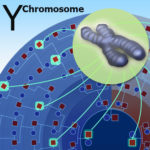Is Transgender Identity Inherited?
The recent return of the “which bathroom?” issue regarding transgender individuals’ use of public restrooms has made me think about how I’ve handled sex and gender in my human genetics textbook. Over the editions, the two topics have diverged. And that’s at the crux of misunderstanding.
SEX AND GENDER THROUGH THE EDITIONS
 When I wrote the first edition in 1993, coverage of the X and Y chromosomes that make us female or male (sex determination) was squished into a chapter on genetic linkage. I didn’t mention gender identity at all.
When I wrote the first edition in 1993, coverage of the X and Y chromosomes that make us female or male (sex determination) was squished into a chapter on genetic linkage. I didn’t mention gender identity at all.
By the second edition, “Matters of Sex” was its own chapter, starting with a table called “Sexual Identity.” The last entry was “gender identity,” defined as “Strong feelings of being male or female, from childhood.”
In early 1998, while writing the third edition, I read John Colapinto’s unforgettable article in Rolling Stone (summarized by Colapinto here) about David Reimer (1965-2004). After David’s penis was removed following a botched circumcision, his parents were pressured into raising him as a girl, and the infant underwent the first “sex reassignment” surgery performed on an anatomically normal individual. It’s a complex tale. The physician regarded David (then named Brenda) as part of a science experiment of sorts by comparing her to his identical twin Brian.
Brenda/David, however, always knew he was a he, preferring boys’ games and attire, even peeing standing up without knowing why. When a psychiatrist finally told him of his beginnings at age 14, David sought surgery to return to his male origin.
With David’s help, Colapinto published “As Nature Made Him: The Boy Who Was Raised As A Girl ” in 2000. About that time, I wrote an article, “Reevaluating Sex Reassignment”, for The Scientist, concluding from interviewing experts that “Both clinical trials and case reports powerfully argue for nature over nurture in establishing gender identity.” On the surface, that statement could mean that a baby with a penis becomes a man and a baby with a vagina becomes a woman, no matter what. But it also argues for the power of knowing one’s gender, whether one has the corresponding anatomy or not.
David Reimer’s sad story entered my textbook with the third edition. The next leap in my coverage of gender happened after I met Jennifer Finney Boylan, who was born James.
My daughter Heather and I met Jennifer at a bookstore in 2003, just before publication of Jennifer’s book She’s Not There: A Life in Two Genders. Today she’s an outspoken transgender author who predicted in a New York Times op-ed just after the election that the new president would throw out President Obama’s protection of the right of transgender students to use school bathrooms matching their gender identity. Sadly she was right, even though just last April candidate Trump said that people should “use the bathroom they feel is appropriate.”
At the bookstore all those years ago, Jennifer stayed afterwards to talk with Heather, who was at the time contemplating her future career as a social worker. Jennifer’s bravery and kindness impressed both of us. No one would go through what she did for something trivial, for just a feeling.
So my next textbook edition included this paragraph:
“Transgender is a poorly understood condition related to sexual identity. A transgendered individual has the phenotype and sex chromosomes of one gender, but identifies extremely strongly with the opposite gender. It is a much more profound condition than transvestitism, which refers to a male who prefers women’s clothing. The genetic or physical basis of transgender is not known. Some affected individuals have surgery to better match their physical selves with the gender that they feel certain they are.”
It was a start. I should have replaced “feel” with “are.” To my astonishment, when drafts of that edition were reviewed, instructors asked that the paragraph be removed, because they felt identifying as transgender had nothing to do with genetics.
I refused. We can’t say a characteristic isn’t genetic just because we don’t yet have any evidence. But in the next few editions, I fielded the same request, and again ignored it. Writing a textbook brings an authority beyond a mere article or blog post, and I wanted people wondering about the role of genetics in transgender identities, and taking a course in human genetics to at least find a definition in their textbook.
Meanwhile, I started to wonder if certain genotypes in some way contribute to the overwhelming sense that gender doesn’t match genes, chromosomes, or gonads.
HERE’S WHAT WE KNOW: BIO 101
Sex is set, or “determined,” when an X chromosome from an egg finds itself in a nucleus with an X or a Y from a sperm. XX=female: XY=male.
For six weeks, the embryo unfurls two sets of “indifferent” gonads, with two sets of plumbing. At week 6, a gene on the Y called SRY, for “sex determining region of the Y,” turns on and the fledgling female parts shrivel away. Without SRY, and under guidance of other genes, the male structures vanish instead. So anatomically we all start out with a bit of both.
Mess with the genes and chromosomes behind our sexuality, and mismatches arise. A mutation in a gene called Wnt4, for example, disables the switch to femaleness, and an XX embryo drowns in testosterone. Vagina, cervix, and uterus never develop. In fact, SRY was discovered in people who looked female but were XYs missing SRY, and people who looked male but were XXs with an SRY gene plunked onto one of the X’s. Another type of female with XY chromosomes has androgen insensitivity syndrome, lacking receptors on cells that bind testosterone, cutting of the hormonal signals necessary for maleness. Several historical figures supposedly had this condition.
Most fascinating is 5-alpha reductase deficiency, in which life begins as a girl, based on appearance. The enzyme to convert testosterone into the form needed to sculpt a penis isn’t there, and so external male structures don’t develop early on, although interior structures are male. At puberty, the adrenal glands release testosterone, as they normally do, and then the voice deepens, facial hair grows, muscles become leaner, and instead of developing breasts and menstruating, the clitoris swells into a penis and sperm are produced.
In the Dominican Republic, where 5-alpha reductase deficiency is more common due to relatives marrying relatives awhile back, these special adolescents are given their own gender name— guevedoces, for “penis at age 12” – and are fully accepted as whatever they want to be. Most become fertile males. Discovery of the fact that guevedoces have small prostates led to development of the drug finasteride, which inhibits 5-alpha reductase and is used to treat enlarged prostate. The Pulitzer-prize-winning novel Middlesex, by Jeffrey Eugenides, tells the story of a young man with the condition. It’s one of my all-time favorite books.
So the X and Y chromosomes determine sex, unless a single-gene mutation intervenes and then they don’t. Could gene variants, perhaps specific sets of them, somehow set the stage for the gestation of a transgender individual? For the upcoming twelfth edition of my textbook, I took a look.
SCANT EVIDENCE FOR TRANSGENDER GENES
A genome-wide association study (GWAS) might be the way to go to identify genes that have variants that affect gender identity. Scan the genomes of a few hundred or thousand transgender individuals and a similar number of controls, perhaps their cisgender siblings, for a few million SNPs (single nucleotide polymorphisms; places in the genome where a DNA base varies in a population). Identify gene variants shared only among the trans. Then look in those genome regions for genes whose functions make sense – this might be more objective than rounding up the usual suspects, such as hormone receptors and enzymes needed to synthesize steroids.
- 23andme indeed conducted a GWAS in 2012, but on sexual orientation — hetero, homo, and bi. Not the same thing.
- A 2008 study found a SNP in CYP17, making it a “candidate” gene for transgender individuals. Trans men were more likely to have the variant than cis women. The gene controls sex hormone production.
- A just-completed clinical trial ruled out the 5-alpha reductase penis-at-12 gene (SRD5A2) as a candidate.
 That’s it. Or at least all I could find. Although clinicaltrials.gov lists 58 studies under “transgender,” nothing much comes up in the way of genetics. The closest was the “exploration of the neovagina” study to investigate ways to entice a vaginal microbiome to flourish in a surgically created organ.
That’s it. Or at least all I could find. Although clinicaltrials.gov lists 58 studies under “transgender,” nothing much comes up in the way of genetics. The closest was the “exploration of the neovagina” study to investigate ways to entice a vaginal microbiome to flourish in a surgically created organ.
A genomewide SNP screen, or even genome sequencing, might one day identify a genetic “signature” for individuals more likely to identify as transgender. Should we even go there? I don’t think so. What good could it do? People who identify as transgender already know it – it’s certain others who have a problem with it. And imagine new parents of a girl told she will identify as a boy, or vice versa. What would they do? I’d say just wait and see. Let it be.
I’m not a psychologist and clearly out of my depth when matters get beyond genes and chromosomes. Comments welcome! (Are any other nerds glad to hear cis and trans outside of the context of rotation around a double carbon bond or the orientation of allele pairs?)




[…] Source: Is Transgender Identity Inherited? […]
As a nurse, my curiosity & minor research says YES due to a mixup of hormones & chromosome Logic says who would choose to have those problems!!
I’m a trans person myself and I want to thank you for this easy to understand and respectful article. Through your writing I can tell you are such a friendly person.
Thank u for this article- grandma of a trans child
Assuming that all genes determining biological sex (XX and XY) are present and contain the usual types of DNA bases in their proper sequence, there is still the possibility that there are genes that affect the neurological “feeling” of gender identity. There is scant evidence that such genes exist (as far as I know). If they do exist, another line of scientific inquiry could expand the complexity of the sex-gender relationship.
LOVE that child regardless of what they choose to do!
Yes we need the further studies in order for the haters and insurance companies to allow medical care to happen for transgender people of all ages. In Texas medical professionals are being threatened and are fearful of danger to their careers if they continue treating transgender youth. And transgender people will continue to be ostracized and treated as freaks if people do not understand that being transgender is something one is born with — just like tallness, shortness, eye sight issues, heart problems sooner or later and so forth.
Very well said. Thank you.
Trans guy here! I really enjoyed reading this. I agree with you that finding a “cause” of being transgender might not do any good. I wonder if knowing one way or the other in advance might tempt the parents to encourage one way or the other, for better or worse. I definitely worry too about the possibility of people not wanting to keep a child if they know they may be transgender, or not wanting people who may pass on the transgender gene(s) to be able to have kids. But like Patricia said, doing scientific, medical research would absolutely help us access medical care (both transition related and in general, like normalizing trans guys who are legally male accessing reproductive healthcare), and help our existence be accepted as valid. I wonder if psychology-focused research might be better than genetic research, to avoid the ability to predict transgenderness while still asserting its validity and the benefits of living as one’s true self. Anyway I’m glad I stumbled on this!! You’re clearly an ally, and I appreciated your thoughtful analysis and respectful language. And I love how your thoughts have been fluid with time as you’ve reflected more and met more people! Cool!
I know for a fact, because of secrets in my family after some “males” passed, that at least in my case, it runs in the family. i strongly believe there are strong genetic lines leading to a trans person, whether cis people think this is the case or not.
I agree, but thinking and believing won’t answer the question. Science might. But that could lead to more issues and problems and be misused.
“Scant evidence for transgender genes.”
But, perhaps controversially, a stochastic amount of evidence for the other form of information transfer. Memes.
We only have to look at the way that gay men and women have cross-dressed (and I’m not referring to, mainly men who do so for sexual pleasure) rather those people who are traditionally gay or homosexual if you prefer and a population that has been ostracised across the millennia.
Genes transfer information vertically (except for bacteria which are just … want to be bloody different) while memes transfer it horizontally – from person to person. The idea that we’re attracted to the same sex appears to manifest in some people with the desire to appear more masculine (for women) and feminine (for men) and I’ve seen this play out with some rather cruel names that I won’t repeat here as there is simply no need.
But what if someone were to ether arrive at the idea (or worse, have it suggested) that they were actually in the wrong sexed body.
I used to believe the DSM’s position (and then I remembered that the DSM also used to consider homosexuality as a MH condition which it plainly isn’t. Then I applied that to “what if” memes were involved and what would happen if those memes got lose.
We don’t need to wonder – IF this hypothesis which, while promising, is all it is is correct. Because we could have predicted as politicians and other people with large platforms (read Social Media) want to hit those disaffected groups, all they need to to is show compassion.
Then it hit me – this is what Harriet Harman did in the UK back in the mid-1970s. Now we can’t compare Harman’s ineptitude with what’s happening now but the rise of social media has definitely created entire echo chambers where all manner of (legal and often even illegal) ideas are birthed and proliferate. Where Harman’s example is salient though is the way she just wanted to align herself with what was then a disaffected group and who cared about a few kids… Um. well…
But this is where we are now.
Imagine a child entering puberty. Hormones raging and perhaps no idea why they are attracted to someone of the same or opposite sex. That confusion is ripe (as is the vast fertile land of their mind) for infection by any passing meme (mind virus). Including the idea that, “you’re not gay, you were born with the wrong set of reproductive organs”.
Once again, I think it’s worth pointing out here that this excludes all intersex variants of which there are many and stick to the “normal” range on the bell curve. The middle 80+% or more. Those who are “cis” gendered.
Plant the idea that they are in the wrong body and then welcome them into your group (under your wing) where they find comfort and solace from the horrible hand nature has dealt them – by which I mean raging hormones – and it doesn’t take genius to work out what happens next.
There are a rising number of de-transitioners – not a large number, YET, but that number is growing as the number of gender affirming clinics and the silencing of anyone who doesn’t tow this line becomes more vitriolic.
This is where stochastic analysis has to be applied. We can’t experiment on people because the ethics is a bloody minefield – but the correlation between the relaxing of ideas, the rise of social media echo chambers and the number of people *self*-identifying cannot be overlooked.
Politically, I’m fairly hard left-leaning. I’m not some knuckle-dragging “traditional family” right wing American loon like Ben Shapiro but I’m also not about to be told what to think.
This is the second area where memes come into play. Memes (information transfer) also create tribes. Right wing, left wing, soccer supporters, celebrity “fandom” and so on. But look at these groups. See how combative their members get when there’s a challenge.
Obesity (another epidemic started by a bunch of male “perverts” in the 1960s) has now morphed into the body acceptance movement and anyone who points out that (in all but a few edge cases) these people are not just sending themselves to an early grave but are encouraging their followers to do precisely the same thing.
And anyone with a modicum of medical knowledge (or can read the associations with cancer, and other obesity related diseases) who dares to do what I’m doing here is going to be mobbed.
Memes are a newish area of science, Dawkins coined the term although the idea is much older.
For a nice example if you don’t believe me: consider how religions moved over time. Up until the invention of the printing press, religion was the preserve of a few learned men (yeah, patriarchy right there) and then the press arrived. Suddenly loads more people had easy access to that information.
And then came the telephone, telegraph and wireless (radio).
Then television.
The Internet.
The the web and latterly social media.
Every time there is a leap in the speed of information transfer the most powerful memes become more widespread and dominant.
And maybe it’s time we started paying them attention.